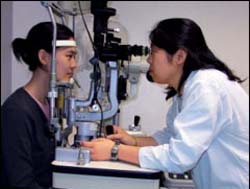

Amblyopia, commonly known as lazy eye, is a developmental disorder of spatial vision in the absence of any detectable structural or pathologic abnormalities that cannot be corrected by refractive means. Prevalence estimates range from 1% to 5% depending on the population studied and the definition used.
The condition occurs when a child's eyes are misaligned and one eye begins to shut down. It is generally treated by putting a patch over the better eye to strengthen the weaker one. Until recently, the long-standing belief among doctors has been that if the disorder is not caught by about the age of 8, it is too late to do anything about it. Untreated, the condition can cause permanent vision loss in the affected eye.
In cooperation with colleagues from home and abroad, CAS researchers have discovered that young adults with amblyopia improve substantially and retain their gains after receiving a new treatment they have developed.
As reported online in a recent issue of the journal Vision Research, a research team, led by Prof. ZHOU Yifeng, an expert in visual information processing from the CAS affiliated University of Science and Technology of China and Institute of Biophysics, suggests that the visual system of adult amblyopes might still retain substantial plasticity and there is a way to help people with lazy eye who are in their late teens or older.
For the study, the researchers took 23 people with lazy eye, ages 14 to 27, and divided them into different groups. Over a period of 9 to 19 days, using a computer screen, members of two groups were taught to improve their contrast perception in the affected eye, said Prof. Zhong-Lin Lu from the University of Southern California in US, who is co-author of the paper and primary investigator.
The researchers trained the subjects in detection of a near-threshold "sine-wave grating", a set of contrasting dark and light modulations that neurophysiologists have identified as a basic unit of visual perception.
Surprisingly, a marked improvement has seen in standard vision tests. The seven subjects improved their overall visual acuity 25 to 216 percent, with an average of 70 percent.
Another 10 subjects in a slightly different training program showed an average improvement of 46 percent. Eight subjects in a control group showed no improvement.
Amblyopia is sometimes due to a misaligned eye that can be reoriented surgically. But in many cases the eye is perfectly healthy, Lu said, "The problem is actually in the brain. This is a neural deficit."
Next, the researchers plan to test their method on patients at a clinic in China. Other plans include developing a home training program. "It could become a clinical procedure," Lu said.

86-10-68597521 (day)
86-10-68597289 (night)

86-10-68511095 (day)
86-10-68512458 (night)

cas_en@cas.cn

52 Sanlihe Rd., Xicheng District,
Beijing, China (100864)

